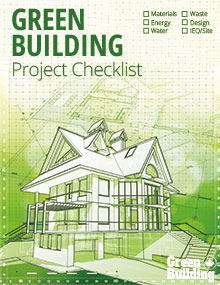However else our lives differ from generations that have come before, one constant that binds us is that the kitchen is still the most important place in our homes. It might not be our central source of heating anymore, but we still rely on it every day, whether to cook meals or at least to get a glass of wine from.
If your kitchen is in need of a serious renovation to bring it into contemporary times, or if you’re building from scratch, here are some ways to ensure you design a sustainable kitchen from bottom to top.
The Envelope
Gutting your kitchen (or starting from scratch) gives you an excellent opportunity to maximize the efficiency of your building envelope. If you’re building a new kitchen, know that timber framing is not your only option. Insulated concrete forms (ICF), compressed earth blocks or other earthen wall systems, straw bales, dense packed cellulose, hempcrete and structural insulated panels (SIPs) are just some high-performing choices above and beyond conventional framing techniques.
Air sealing and adding high-performing insulation during a renovation can make walls as efficient as possible. Before you add anything, though, have a knowledgeable contractor advise you about how your insulation efforts might impact the rest of the home. Your home functions as a system, and you don’t want to create problems in other areas of the home by making one room extra airtight.
Floors
Flooring is an easy place to incorporate sustainable materials. Certified hardwood products, bamboo or cork are options that have a warm feel on your feet. If humidity is an issue in your home, or if you anticipate lots of watery spills, you might want to steer clear of bamboo and cork, however, since they can be prone to moisture damage.
Natural ceramic or porcelain tile, slate and other stone floorings are cooler on the feet, but very hard-wearing. Stone floors will need to be properly sealed to resist stains.
Don’t discount linoleum, if you’re searching for a maintenance-free, hard-wearing option for your sustainable kitchen. Real linoleum differs from the vinyl sheeting that dominated the last half of the 20th century. Linoleum is made from wood fillers and linseed oil, so it’s a very eco-friendly choice. If you investigate this option, make sure the product, and the adhesives use to apply it, are in fact certified green and free of VOCs.
Windows

Design your kitchen to make the most use of natural light possible. Windows on multiple walls will allow you to capture sunlight at different times of the day, hopefully coinciding with the times you make breakfast and dinner. A skylight can be a wonderful way to add light if there are privacy concerns. After all, no one needs the neighbours watching them fail at a souffle.
Since windows inherently offer less insulation than walls, splurge on the most energy-efficient windows you can afford. Triple-pane glass options are available, but at the minimum, shoot for double-glazed, low-E glass. Vinyl windows are standard, but the most energy-efficient frames are still wood, or wood clad with aluminum. They won’t be cheap, but they will reduce the amount of heat transfer ordinary windows allow. Look for windows that have an Energy Star rating.
Lighting
Choosing LED lightbulbs is a no-brainer for energy efficiency. You can go above and beyond your choice of lightbulb when you’re planning your eco-friendly lighting, though. Task lighting is more efficient than keeping a large overhead light fixture on, so include some strategically placed smaller lights over your sink and over the counterspace where you think you’ll work most. Save the overhead light for mealtimes (if you have an eat-in kitchen) or for times when multiple people are cooking, or pestering the chef, at once.
Also consider including some LED fairy lights if your kitchen light tends to be the one that’s left on for members of the household who come in late at night. They offer enough light to guide someone’s way, use a fraction of the energy of larger light fixtures and are also charming and fun.
Appliances
If you need new appliances, look for the Energy Star rating. If you’re on the fence about using your old ones, be mindful that the cost of buying new appliances won’t be recouped through energy savings for a long time. It’s also green to reduce consumption and keep appliances out of the landfill, so there should be no green guilt about keeping an old appliance running.
Make an appliance purchasing plan based not just on the dimensions of your kitchen, but on how much you’ll actually use each appliance. You might have space for a large fridge, but if it will never be stocked, it will use much more energy than you need. If you don’t bake often, maybe you could get away with a cooktop and a toaster oven. When you’re looking for any appliance look for the most energy-efficient, low-waste option.
Counters and Cabinets
Counters and cabinets are another place where natural and sustainable materials can shine. Bamboo is an excellent sustainable choice for cabinetry, as are certified wood products. Search for reclaimed cabinets—reclaimed cabinets are often made to last, but simply look outdated. A quick refinish lets you keep them out of the landfill and greens your sustainable kitchen by reducing the amount of resources used to create something new.
You can get very creative with eco-friendly countertops. Certified wood or bamboo products work beautifully for a rustic aesthetic. Natural stone countertops, while expensive, are a durable and timeless choice. You can go well beyond these classics, however. Recycled glass, aluminum or steel, or composite paper counters, offer more unique and modern-looking options.
Building a sustainable kitchen will reward you with lower maintenance costs, a cozier environment and a healthier cooking space. It will make your most essential room even more essential to your life.
Feature image: Dmitry Zvolskiy; Image 1: Pixabay


